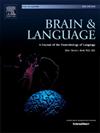发展性语言障碍儿童功能网络连接改变的初步证据
IF 2.3
2区 心理学
Q1 AUDIOLOGY & SPEECH-LANGUAGE PATHOLOGY
引用次数: 0
摘要
发展性语言障碍(Developmental Language Disorder, DLD)是一种常见的神经发育疾病,其特征不仅是语言学习、理解和表达方面的显著困难,而且还包括执行、程序和/或运动功能方面的困难。对DLD中大脑异常的理解仍不清楚,功能MRI (fMRI)研究主要集中在语言网络上。我们使用静息状态功能磁共振成像(fMRI)研究了22名7- 13岁的DLD儿童和23名典型语言发育(TD)儿童的全脑功能连接(FC)。使用基于非参数网络的统计方法,我们发现与TD儿童相比,DLD儿童在整个大脑中具有广泛的下FC网络。特别是,感觉运动(SM)、认知控制(CC)和默认模式(DM)网络包括最大数量的FC改变。其中,DM网络内部、SM与DM网络之间、SM与CC网络之间的FC链路变化最大。没有发现DLD患儿的FC明显高于TD患儿。据我们所知,这是对DLD儿童静息状态FC的首次调查,显示了广泛的功能性大脑异常,不仅限于语言网络,而且涉及支持其他认知和运动功能的网络。这种广泛的功能异常为DLD的其他认知和运动障碍提供了潜在的解释。本文章由计算机程序翻译,如有差异,请以英文原文为准。
Initial evidence of altered functional network connectivity in children with developmental language disorder
Developmental Language Disorder (DLD) is a common neurodevelopmental condition characterized by not only significant difficulty with language learning, comprehension, and expression but also with executive, procedural and/or motor functions. The understanding of the brain abnormalities in DLD remains largely unclear and functional MRI (fMRI) studies have largely focused on the language network. Using resting-state fMRI, we investigated whole-brain functional connectivity (FC) in 22 children with DLD and 23 with typical language development (TD), aged 7-to-13-years. Using a non-parametric network-based statistics approach, we found that children with DLD had an extensive network of lower FC across the whole brain, compared to the TD children. In particular, the sensorimotor (SM), cognitive control (CC) and default-mode (DM) networks included the largest amounts of altered FC. In detail, FC links within the DM network and between the SM and DM networks, and between the SM and CC networks were the most altered. No FC was found to be significantly higher in the children with DLD than in their peers with TD. To our knowledge, this is the first investigation of resting-state FC in children with DLD, showing widespread functional brain abnormalities that are not limited to the language network, but rather involve networks supporting other cognitive and motor functions. Such extensive functional abnormalities offer a potential explanation for the other cognitive and motor impairments characterizing DLD.
求助全文
通过发布文献求助,成功后即可免费获取论文全文。
去求助
来源期刊

Brain and Language
医学-神经科学
CiteScore
4.50
自引率
8.00%
发文量
82
审稿时长
20.5 weeks
期刊介绍:
An interdisciplinary journal, Brain and Language publishes articles that elucidate the complex relationships among language, brain, and behavior. The journal covers the large variety of modern techniques in cognitive neuroscience, including functional and structural brain imaging, electrophysiology, cellular and molecular neurobiology, genetics, lesion-based approaches, and computational modeling. All articles must relate to human language and be relevant to the understanding of its neurobiological and neurocognitive bases. Published articles in the journal are expected to have significant theoretical novelty and/or practical implications, and use perspectives and methods from psychology, linguistics, and neuroscience along with brain data and brain measures.
 求助内容:
求助内容: 应助结果提醒方式:
应助结果提醒方式:


